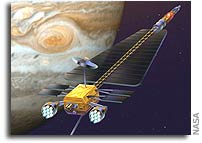Advanced Radioisotope-power Technologies R&D Teams Selected

NASA selected several radioisotope-based power-
conversion technologies for research and development (R&D).
The awards are the first competitive technology procurement
funded wholly by NASA’s Project Prometheus.
These systems are distinguished by their use of new
technologies for converting heat from radioisotope fuel into
electrical power. The technologies are intended for use in
improved radioisotope-power systems, which could provide
higher efficiencies and power levels than those used on
existing devices, enabling more sophisticated science
instruments and spacecraft subsystems. The awards cover
several distinct power-conversion technology areas:
Thermoelectrics, Thermophotovoltaics, Stirling Engines, and
Brayton Engines.
“With this award, NASA is laying the foundation for several
technology paths that could enable entirely new classes of
missions, from networked science stations on Mars to small
spacecraft capable of complex maneuvers in deep space using
high-performance electric thrusters,” said Dr. George
Schmidt, Program Executive for Radioisotope Power Systems at
NASA Headquarters. “These new technologies could greatly
expand the nation’s ability to conduct future robotic
planetary-exploration missions in deep space, or in mobile
laboratories on the surfaces of planets and moons,” he said.
Thermoelectrics, the thermal-to-electric power conversion
method used on NASA missions since the early 1960s, has the
advantage of employing no moving parts. Proposals selected in
this area will concentrate on research of new thermoelectric
materials and structures, and could achieve up to two-fold
improvements in efficiency over existing systems. The
Principal Investigators (PIs) selected by NASA’s Office of
Space Science:
- Mildred Dresselhaus (Massachusetts Institute of Technology, Cambridge, Mass.): ‘Si-Ge Nanocomposites for Radioisotope Power Conversion’
- Saeid Ghamatay (Hi-Z Technology Inc., San Diego): ‘Multiwatt Quantum Well Thermoelectric’
- David Moul (Teledyne Energy Systems Inc., Hunt Valley, Md.): ‘Segmented BiTe/PbTe-BiTe/TAGS/PbSnTe Thermoelectric Generators’
- Ben Heshmatpour (Teledyne Energy Systems Inc., Hunt Valley, Md.): ‘Advanced Superlattice BiTe-PbTe/TAGS Milliwatt Radioisotope Power Systems’
Thermophotovoltaics, another method requiring no moving
parts, operates similar to solar cells by converting
electromagnetic radiation of heat to electric current. It
could double or triple current generator efficiency. Selected
PIs:
- Christopher Crowley (Creare Inc., Hanover, N.H.): ‘Thermophotovoltaic Power Conversion Technology for Radioisotope Power Systems’
- William Horne (EDTEK Inc., Kent, Wash.): ‘Thermophotovoltaic Radioisotope Power Conversion Technology’
- Samar Sinharoy (Essential Research Inc., Brookpark, Ohio): ‘A Very High Thermophotovoltaic Converter for the General Purpose Heat Source’
Stirling Cycle Engines (SCE) have the potential of achieving
efficiencies three-to-four times greater than existing
systems. SCE have been used in space for sensor cooling and
cryogenic storage. The selected PIs:
- James Wood (Sunpower Inc., Athens, Ohio): ‘Development of a High-Performance Next-Generation Stirling Radioisotope Power Converter’
- Mounir Ibrahim (Cleveland State University, Cleveland): ‘Developing the Next-Generation Stirling Engine Regenerator: Designing for Application of Microfabrication Techniques and for Enhanced Reliability and Performance in Space Applications’
Brayton Cycle Engines offer the potential of achieving very
high efficiencies and could have the advantage of being
compact and scaleable to higher power levels. The proposal
selected in this area will apply microfabrication techniques
to build and demonstrate a Brayton converter. The selected PI
is Mark Zagarola (Creare Inc., Hanover, N.H.): ‘A Turbo-
Brayton Power System for Radioisotope Power Conversion.’
Each award covers three, one-year performance periods.
Continued support from one period to the next is contingent
on program need, availability of funds, and each PI team’s
ability to meet proposed milestones. The total funding for
this Research Announcement is $43 million, split into $13.4
million, $7.5 million, $16.9 million and $5.2 million
increments for fiscal year 2003 through 2006 respectively.
Project Prometheus, the Nuclear Systems Program, in the
Office of Space Science, NASA Headquarters, manages the
radioisotope power systems research and development. The
Department of Energy, a key partner in this effort, develops
the units used in flight applications. Project Prometheus is
supported by NASA’s Glenn Research Center, Cleveland; Jet
Propulsion Laboratory, Pasadena, Calif.; Marshall Space
Flight Center, Huntsville, Ala.; and Kennedy Space Center,
Fla.








